Pilagá is a Guaicuruan language spoken by 4,000 people in the Bermejo and Pilcomayo River valleys, western Formosa Province, in northeastern Argentina... 7 KB (724 words) - 20:33, 22 March 2024 |
 | letter B. It is used in Northern Embera and Pilagá languages. The orthography of Northern Embera language used in Panama, the letter represents the voiced... 3 KB (219 words) - 18:58, 25 August 2022 |
Wichí (Wichí Lhamtés) Mocoví Nivaclé (Chulupi) Pilagá Quechua Tapieté Toba Qom A large number of languages once spoken in Argentina have disappeared. According... 14 KB (1,322 words) - 07:43, 23 November 2023 |
the approximately 19,810 (2000 WCD) speakers reside. The language is distinct from Toba-Pilagá and Paraguayan Toba-Maskoy. There are also 146 Toba speakers... 14 KB (1,575 words) - 02:33, 17 May 2023 |
Argentina, Paraguay, and Bolivia by the Toba people Pilagá language (Pilaca), a Guaicuruan language spoken in western Formosa Province in northeastern... 487 bytes (96 words) - 17:40, 27 April 2021 |
Toba language here should not be confused with the Mascoy language of the Mascoyan family which is also called Toba (or Toba-Emok, Toba-Maskoy). Pilagá, with... 9 KB (701 words) - 20:19, 19 December 2023 |
An endangered language is a language that it is at risk of falling out of use, generally because it has few surviving speakers. If it loses all of its... 14 KB (171 words) - 00:41, 28 March 2024 |
Doris L. Payne (category Linguists of Nilotic languages) Foundation-funded research project aimed at documenting the Nivaclé and Pilagá languages of northern Argentina. Payne is co-editor-in-chief of the International... 5 KB (483 words) - 12:36, 13 April 2024 |
Numeral (linguistics) (redirect from Numbers in languages) pre-contact Mocoví and Pilagá, Culina and pre-contact Jarawara, Jabutí, Canela-Krahô, Botocudo (Krenák), Chiquitano, the Campa languages, Arabela, and Achuar... 50 KB (3,522 words) - 11:23, 30 March 2024 |
Cayuvava – Bolivia (extinct) Itonama – Bolivia Movima – Bolivia Guaicuruan Pilagá – Argentina Toba – Argentina / Paraguay Mocoví – Argentina Matacoan Chorote... 12 KB (669 words) - 05:03, 10 June 2023 |
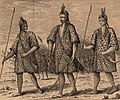 | Abipón (category CS1 Latin-language sources (la)) people of Argentina's Gran Chaco region, speakers of one of the Guaicuruan languages. They ceased to exist as an independent ethnic group in the early 19th... 7 KB (851 words) - 14:23, 18 June 2021 |
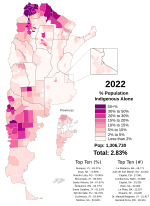 | Indigenous peoples in Argentina (category CS1 Spanish-language sources (es)) parts of Santiago del Estero Province. Charrúa Lule Mbya-Guaraní Mocoví Pilagá Qom Tonocoté Vilela Wichí This region includes the provinces of Catamarca... 33 KB (2,900 words) - 00:37, 25 April 2024 |
 | Toba people (category CS1 Spanish-language sources (es)) indigenous language. In Paraguay, there are around 700 Qom. In the western region of the province of Formosa, the Qom have mixed with the Pilagá community... 73 KB (9,523 words) - 02:56, 2 January 2024 |
(Waikuruan, Waykuruan) Kadiwéu (Caduveo, Mbayá, Ediu-Adig) Southern Guaicuruan Pilagá (Pilaca) Toba (Qom, Namqom) Mocoví (Mocobí) Abipón † Guajiboan (Guahiboan)... 190 KB (4,385 words) - 07:43, 23 November 2023 |
 | Demographics of Argentina (category CS1 Spanish-language sources (es)) Retrieved 15 January 2018. Gordon, Raymond G. Jr. (2005). "Language of Argentina". Ethnologue: Languages of the World, Fifteenth edition. SIL International.... 92 KB (4,776 words) - 20:30, 25 April 2024 |
 | Voiced palatal lateral approximant (category CS1 Spanish-language sources (es)) lateral approximant is a type of consonantal sound used in some spoken languages. The symbol in the International Phonetic Alphabet that represents this... 26 KB (1,469 words) - 22:46, 17 April 2024 |
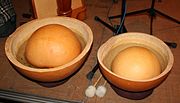 | Water drum (category Articles containing Spanish-language text) America, the cataquí is a water drum used by the Toba (aka Qom), Wichí, Pilagá, Chorote and Nivaclé cultures in the South American Gran Chaco region. The... 9 KB (915 words) - 13:04, 11 February 2024 |
 | Pharyngeal consonant (category Articles containing Ukrainian-language text) Alyutor the language isolate Kusunda of Nepal the Papuan language Teiwa the Guaicuruan language Pilagá the Mayan language Achi the Siouan language Stoney (Nakoda)... 16 KB (1,525 words) - 10:20, 23 April 2024 |
 | Indigenous peoples of the Americas (category CS1 Spanish-language sources (es)) the Pilagá (4,465), the Chané (4,376), and the Chorote (2,613). The Selk'nam (Ona) people are now virtually extinct in its pure form. The languages of... 223 KB (23,352 words) - 20:44, 21 April 2024 |
 | bands speaking similar languages, called Guaycuruan. The major extant branches of the Guaycuru are: Mocoví (Mocobi) Toba Pilagá Kadiweu Other Guaycuru... 14 KB (1,845 words) - 15:15, 8 January 2023 |
 | Linguistic areas of the Americas (category Indigenous languages of the Americas) neighboring languages of lowland Bolivia (Movima pako, Itonama u-paʔu, and Trinitario paku), as well as Guaicuruan (Mocoví, Toba, and Pilagá pioq). An identical... 43 KB (4,117 words) - 17:57, 10 March 2024 |
List of wars involving Argentina (category CS1 Portuguese-language sources (pt)) Moseley, Christopher; Nicolas, Alexandre (eds.). Atlas of the world's languages in danger (3rd entirely revised, enlarged and updated ed.). Paris: UNESCO... 75 KB (448 words) - 12:46, 23 April 2024 |
 | Voiced pharyngeal fricative (category CS1 Indonesian-language sources (id)) approximant or fricative is a type of consonantal sound, used in some spoken languages. The symbol in the International Phonetic Alphabet that represents this... 11 KB (637 words) - 05:38, 31 March 2024 |
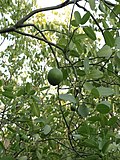 | Morisonia speciosa (category CS1 Spanish-language sources (es)) referred to as atsaj by the Wichí and neloma by the Qomle'ec (Toba) and in Pilagá. Morisonia speciosa is native to the Gran Chaco region and can be found... 10 KB (1,024 words) - 07:06, 4 December 2023 |
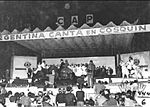 | History of folkloric music in Argentina (category CS1 Spanish-language sources (es)) Cultures such as the Guaycurú (Abipon, Mbayá, Payaguá, Mocoví, Wichí and Pilagá), the Qom and the Avá Guaraní settled in the Chaco area. Like the Pampan-Patagonian... 138 KB (16,343 words) - 20:37, 7 February 2024 |





